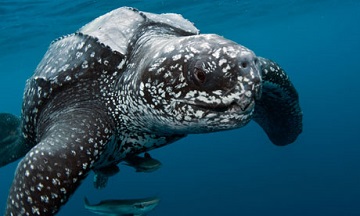Eighty sea turtles wash up dead on the coast of Guatemala
 An assortment of marine animals and birds reside along the black volcanic sand beaches of Guatemala’s Pacific coast, but lately both residents and visitors on the southeast beaches of the country have observed a tragic event – the stranding of dead sea turtles.
An assortment of marine animals and birds reside along the black volcanic sand beaches of Guatemala’s Pacific coast, but lately both residents and visitors on the southeast beaches of the country have observed a tragic event – the stranding of dead sea turtles.Eighty dead sea turtles have been recorded since the first week of July on the beaches of La Barrona, Las Lisas, Chapeton and Hawaii according to a statement released by the Wildlife Rescue and Conservation Association (ARCAS), a Guatemalan non-profit organization formed by citizens in 1989.
“The entire coast has historically been a significant nesting area for olive ridley and leatherback sea turtles,” Colum Muccio, ARCAS administrative director, told mongabay.com. While not known to nest in Guatemala, east pacific green turtles forage in estuaries and mangrove waterways along the Pacific coast.
Tucked between Mexico and El Salvador, the 250 kilometers of coast is divided by 14 river mouths and peppered with beautiful mangrove wetlands and lagoons. In 1993, ARCAS initiated conservation activities in the Hawaii area with hopes of counteracting threats to leatherback and olive ridley sea turtle populations. The leatherback sea turtle (Dermochelys coriacea) is currently listed as Critically Endangered by the IUCN Red List, while the olive ridley (Lepidochelys olivacea) is listed as Vulnerable.
“We manage two of the 24 hatcheries on the Pacific coast of Guatemala, and carry out research and advocacy for sea turtle conservation,” Muccio said.
According to the statement, nearby residents are worried because sea turtles are a valuable resource. Not only do the sea turtles draw tourists to the coast, but, despite their endangered status, the eggs are also a source of income.
“Sea turtle conservation efforts in Guatemala rely on the use of hatcheries, which are managed as part of a quasi-legal egg harvest,” Muccio said. “Villagers are permitted to collect eggs that are deposited on Guatemalan beaches on the condition that 20 percent of each clutch is donated to a nearby hatchery.”
The system was initiated in the mid 1980s to promote the sustainable use of sea turtle eggs, Muccio continued. The operating hatcheries along the Pacific coastline function at various levels based on financial resources of the administering organization.
Muccio states many hatcheries are underfunded, short-staffed and operating with limited scientific knowledge. Several hatcheries do not carry out beach monitoring or research activities, contributing to the deficit in accurate nesting and stranding data.
“Many projects are lacking in the key elements necessary for the present community-based conservation system to function successfully,” Muccio said.
In addition to egg harvesting, one of the main threats to sea turtles on the Pacific coast of Guatemala is fisheries by-catch. The statement notes that the appearance of dead turtles on the beach coincides with the presence of shrimp trawlers in waters off these beaches.
“I don’t think it’s a coincidence that when shrimp trawlers appear in the ocean that we begin having stranded turtles,” Muccio said.
Although Guatemalan trawlers are required to use turtle excluder devices (TEDs), Muccio said that enforcement is difficult and fines are very light.
“We are currently working on instituting a ban on bottom trawling,” said Muccio. “This has recently been done in Belize, Costa Rica and Ecuador and El Salvador doesn’t allow them closer than 3 miles from shore.”
Leading marine turtle conservationists and researchers presented a petition to the government of Guatemala expressing their concern. According to the statement, the petition requests that the government take action to counter the mortality of sea turtles, including the monitoring of shrimp trawlers to establish the impact on marine turtle populations.
“Sea turtles are also very much part of the identity of the local culture and local communities often take pride in their hatcheries and their contributions to save the sea turtle,” Muccio said.
You can return to the main Market News page, or press the Back button on your browser.

